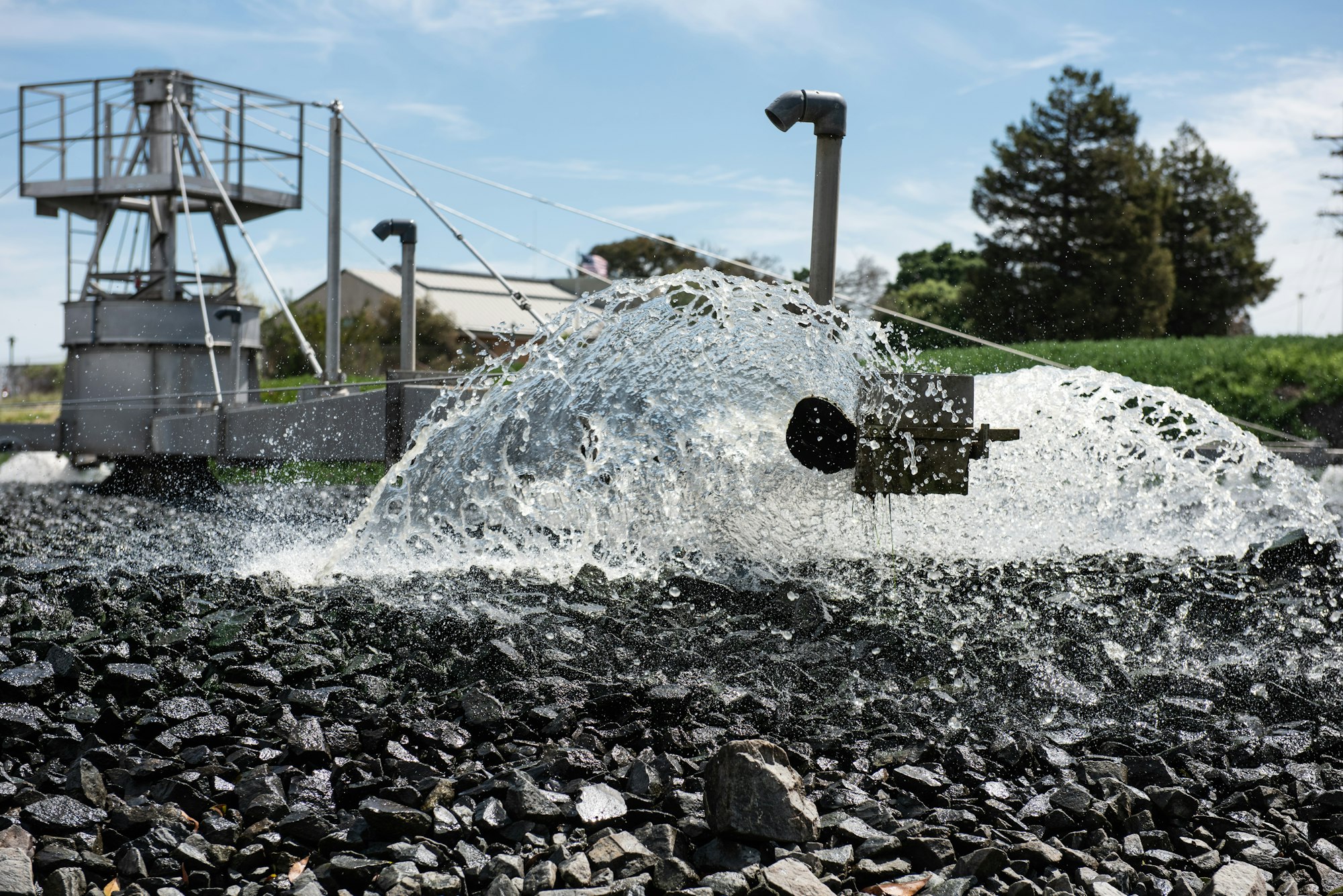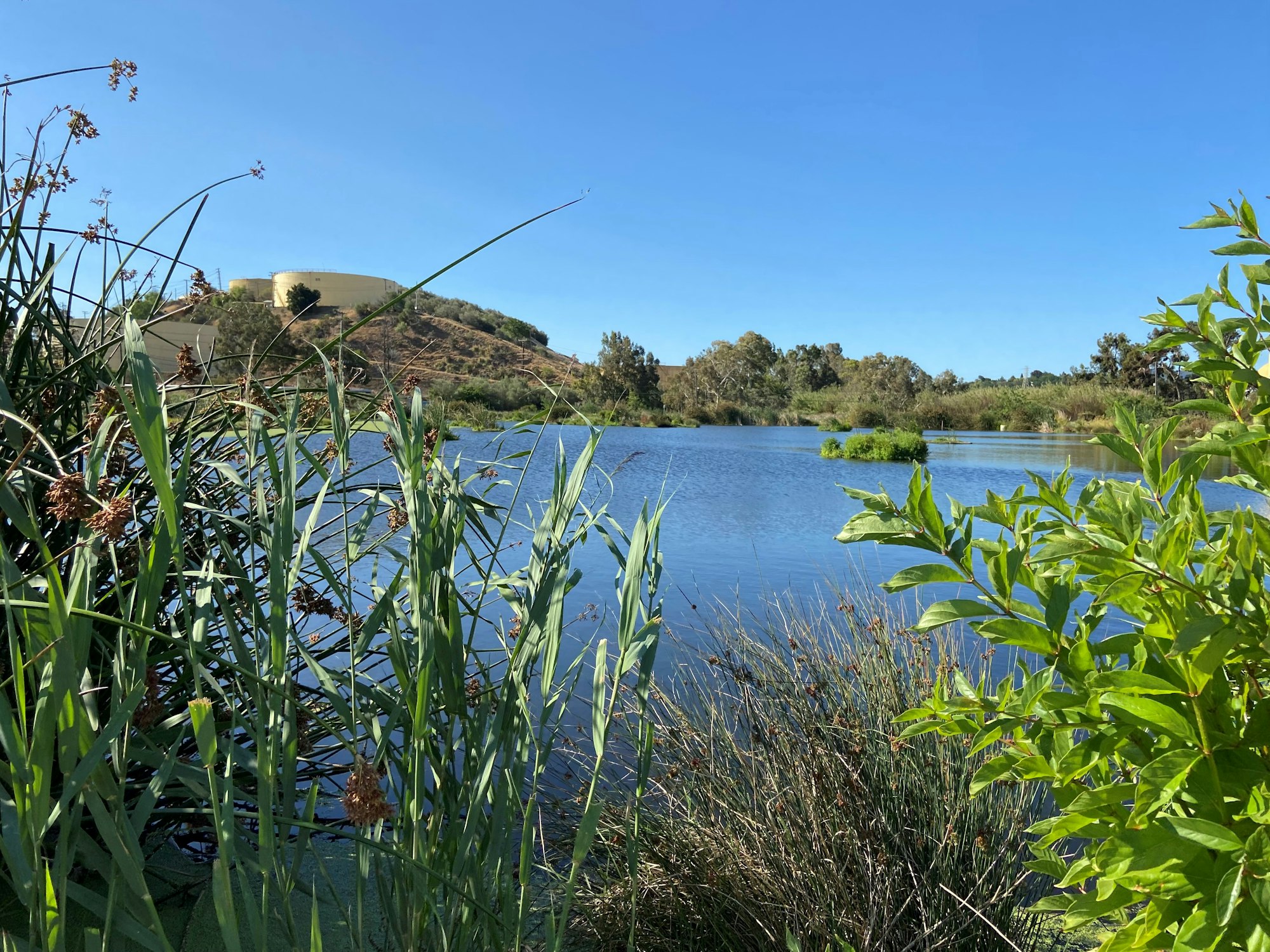What Does That Do?
This is MVSD's series on our wastewater treatment process and how we keep things flowing from your homes and businesses. Come learn with us and find out, "What Does That Do?"
Headworks
You flush and the wastewater travels through a series of pipes and starts the treatment process here! Bar screens remove large debris that could damage plant equipment further downstream. In this picture, the screens have caught a feminine hygiene product and a cleaning wipe; both examples of things not to flush down the toilet. These non-flushable items don't just clog, they damage equipment and your sewer lateral at home. You should only flush the 3 P's - pee, poop, and toilet paper.


Primary Clarifier
The Primary Clarifier is the second stop in the wastewater treatment process. The flow of wastewater is slowed here to allow heavy particles to settle to the bottom of the tank below ground level. With wastewater separated from solids, each takes a different path through the treatment plant.


Here, the operators are monitoring the sludge blanket (solids that have settled to the bottom) in the clarifier. This ensures that the sludge extraction pumps are used efficiently and that poorly settled sludge does not carry over into other paths.

Biofilter
The Biofilter is the third stop in the wastewater treatment process. Wastewater is continuously distributed from the rotating arms onto rocks that are home to microorganisms that break down organic material. These conditions mimic the environment of rocky stream beds and ocean coasts.


Here the MVSD operators are slowing down the biofilter arms so they can be cleaned along with other routine maintenance.

Biotower
Meet the Biotower, the fourth stop in the wastewater treatment process. Wastewater is continuously distributed from the rotating arms onto cross flow media or corrugated plastic sheets. Bacteria living on these sheets converts ammonia in the wastewater to nitrates, a form of nitrogen that is non-toxic. The wastewater is still traveling, so stay with us on the final legs of journey!

Secondary Clarifier
The Secondary Clarifier is the fifth stop in the wastewater treatment process. After leaving the biotower, the flow of wastewater is slowed once again to allow heavy particles to settle to the bottom of the tank below ground level. Any remaining solids are sent one way with the wastewater moving to the sand filtration system.

Sand Filtration System
The Sand Filtration System is the sixth step in the wastewater treatment process. As wastewater continuously flows through the sand filter, the filter media is continuously cleaned by recycling the sand internally through an airlift pipe and sand washing. The cleansed sand is redistributed on top of the sand bed, allowing for a continuous, uninterrupted flow of filtrate and reject (backwash) water. The reject water goes back to the treatment plant and the treated water moves on to the next step...

Ultraviolet Light Disinfection
Ultraviolet (UV) Light Disinfection is the seventh step in the wastewater treatment process. As wastewater flows through the UV system, a concentrated dose of ultraviolet light destroys any harmful microorganisms that may still be present. MVSD was the first Public Owned Treatment Works in Northern California to use UV for disinfection on a full-scale operation and eliminated the use of hazardous materials like gaseous chlorine and sulphur dioxide.


Moorhen Marsh
The last step in the wastewater treatment process is Moorhen Marsh. The treated wastewater, or effluent, from the treatment plant is discharged here. The effluent is the only source of water for Moorhen Marsh. The effluent flows through a series of ponds that make up Moorhen Marsh, into Peyton Slough, through other marshes, into Carquinez Strait, and eventually to San Francisco Bay. Within Moorhen are 42 floating islands, fully stocked with native plant species, that act as a natural treatment for nutrient removal.


To keep Moorhen Marsh looking its best, our interns work diligently on removing invasive plants that try to take over the California native plants. This allows the native plants to flourish, keeps the pathways clear for visitors, and the wildlife active and healthy.
Now, it's time to learn what path the solids take in the wastewater treatment process...
Gravity Sludge Thickener
During the clarification process, there is the separation of liquid and solids. The solids are sent to the Gravity Sludge Thickener, another settling tank that further separates solids from liquids. The sludge from the bottom of the thickener is pumped to our next stop, the Primary Digester. Any remaining water is sent back through headworks.

You can see in the video, the arm moves very slowly to move all of the floating solid waste to the bottom of the thickener.
In order to keep things flowing properly, the operators were hard at work replacing a valve on pump #3 that runs to the sludge thickener. Here you can see close-ups of the old valve removed and the new ones ready to go in its place. In the video, you see the patience and finesse it took to remove it safely.


Sludge Dewatering
The Mt. View Sanitary District uses an Alfa Laval Sharples® Centrifuge. A centrifuge spins at a very high speed, forcing water and solids to separate. With this unit, we take sludge that is about 2% solids and remove water to increase it to approximately 20% to 25% solids. The water is returned to the influent wet well for treatment and the solids are sent to a landfill. The centrifuge enables us to achieve a high solids concentration, reducing hauling costs.


Biosolids
The last step in this journey is seeing these solids, called biosolids, hauled away from the MVSD facility. In the video, you can see the biosolids coming from the centrifuge and placed into a truck trailer, which will haul it to a landfill to be used as alternative daily cover.
More tools of the trade...
Easement Jetter
Meet the Easement Jetter. The jetter supports sewer collection pipe maintenance and is configured to enter tight locations and easements. It holds 600 gallons of water in open tanks that are filled from fire hydrants. The truck carries two one water regulators, one for city and one for county. It’s equipped with a closed-circuit television (CCTV) camera, used to inspect and assess the pipe interiors. Here the operators are performing routine maintenance to ensure the lines are flowing properly. Normally lines are cleaned upstream, but steep hills and long sections are difficult to clean so then it's downstream. Roots, fats, and grease flow back and the operators remove it by hand.
Vac-Con
Like the Jetter, the Vac-Con is used for sewer collection pipe maintenance. The Vac-Con is larger and holds 800 gallons of water, along with being equipped with a vacuum to remove large debris that collects after cleaning the lines. The bigger hose is on a reel and secured by an outrigger to hold it in place while the hose is lowered into each manhole. Multiple lines can be seen in the videos and the operators cleared all of them.
Come back soon to learn more about what these things do at Mt. View Sanitary District!
